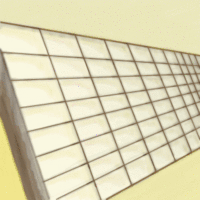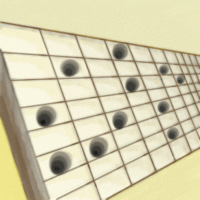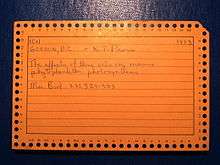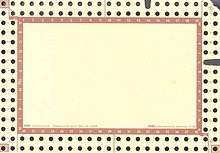Edge-notched card
Edge-notched cards are an obsolete technology used to store a small amount of binary or logical data, encoded into the presence or absence of notches in the edges of paper index cards. The notches allowed efficient sorting and selecting of specific cards matching desired criteria, from a larger number of cards in a paper-based database of information.
Semen Korsakov's Linear Homeoscope

Semen Korsakov was reputedly the first to use punched cards in informatics for information store and search. While working in the statistics department of the Russian Police Ministry, Korsakov became intrigued with the possibility of using machinery to "enhance natural intelligence". To this end, he devised several devices which he called "machines for the comparison of ideas".[1] These included the "linear homeoscope with movable parts", the "linear homeoscope without movable parts", the "flat homeoscope", the "ideoscope", and the "simple comparator". The purpose of the devices was primarily to facilitate the search for information, stored in the form of punched cards or similar media (for example, wooden boards with perforations). Korsakov announced his new method in September 1832, and rather than seeking patents offered the machines for public use.[2][3]



Edge-notched cards or McBee cards
These are a manual data storage and manipulation technology invented in 1896 and used for specialized data storage and cataloging applications through much of the 20th century. While there were many variants, a popular version consisted of 5-by-8-inch (13 by 20 cm) paperboard cards with holes punched at regular intervals along all four edges, a short distance in from the edges. The center of the card might be blank space for information to be written, or contain a pre-printed form.

To record data, the paper stock between a hole and the nearest edge was removed by a special notching tool. The holes were assigned a meaning dependent upon a particular application. For example, one hole might record the answer to a yes/no question on a survey, with the presence of a notch meaning "yes". More-complex data was encoded using a variety of schemes, often using a superimposed code which allows more distinct categories to be coded than the number of holes available.
To allow a visual check that all cards in a deck were oriented the same way, one corner of each card was beveled, much like Hollerith punched cards. Edge-notched cards, however, were not intended to be read by machines. Instead, they were manipulated by passing one or more slim needles through selected holes in a group of cards. As the needles were lifted, the cards that were notched in the hole positions where the needles were inserted would be left behind as rest of the deck was lifted by the needles. Using two or more needles produced a logical and function. Combining the cards from two different selections produced a logical or. Quite complex manipulations, including sorting were possible using these techniques.
Before the widespread use of computers, some public libraries used a system of small edge-notched cards in paper pockets in the back of library books to keep track of them.
Needle cards
Needle cards are index cards with text, written by hand or typewriter, that have a line of prepunched holes along one or more sides. By cutting or punching away (notching out) the paper between a hole and the edge of the card, the card is associated with a category. By putting long (knitting) needles through certain holes in a deck of such cards, lifting and shaking gently, cards that belong to a combination of categories can be selected. This tool is less useful for data sets larger than 10,000 records.[4]
Affectionately referred to as "The Knitting Needle Computer", these database-like systems were popular sometime in the 1960s and 1970s. Science teachers may still use these as a teaching tool for relational databases. Indexed card systems can be made with index cards and a hole punch.


See also
References
- ↑ Intellectual machines (Russian)
- ↑ Semen Korsakov's inventions, Cybernetics Dept. of MEPhI (Russian)
- ↑ Trogemann, Georg (eds.); et al. (2001). Computing in Russia. Verlag. pp. 47–49. The article is by Gellius N. Povarov, titled Semen Nikolayevich Korsakov- Machines for the Comparison of Philosophical Ideas
- ↑ Sture Allén, Språklig databehandling (1970), page 19.
- Williams, Robert V. (2002). "Punched Cards: A Brief Tutorial". IEEE Annals - Web extra. Retrieved 2006-10-30.
- The McBee Keysort System for Mechanically Sorting Folklore Data The Journal of American Folklore, Vol. 66, No. 262, Oct. - Dec., 1953
External links
- A comprehensive article by Kevin Kelly on edge-notched cards
- An article showing an edge-sorting sorting tool in use: J. Chem. Doc., July 1961.
- An article about use of E-Z Sort cards for anesthesia records
- plakboek: An old library book card
- Computer History Museum: Indecks Research Deck needle sort punch card kit